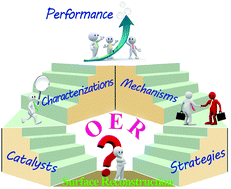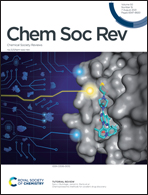Recent advances in activating surface reconstruction for the high-efficiency oxygen evolution reaction
Abstract
A climax in the development of cost-effective and high-efficiency transition metal-based electrocatalysts has been witnessed recently for sustainable energy and related conversion technologies. In this regard, structure–activity relationships based on several descriptors have already been proposed to rationally design electrocatalysts. However, the dynamic reconstruction of the surface structures and compositions of catalysts during electrocatalytic water oxidation, especially during the anodic oxygen evolution reaction (OER), complicate the streamlined prediction of the catalytic activity. With the achievements in operando and in situ techniques, it has been found that electrocatalysts undergo surface reconstruction to form the actual active species in situ accompanied with an increase in their oxidation state during OER in alkaline solution. Accordingly, a thorough understanding of the surface reconstruction process plays a critical role in establishing unambiguous structure–composition–property relationships in pursuit of high-efficiency electrocatalysts. However, several issues still need to be explored before high electrocatalytic activities can be realized, as follows: (1) the identification of initiators and pathways for surface reconstruction, (2) establishing the relationships between structure, composition, and electrocatalytic activity, and (3) the rational manipulation of in situ catalyst surface reconstruction. In this review, the recent progress in the surface reconstruction of transition metal-based OER catalysts including oxides, non-oxides, hydroxides and alloys is summarized, emphasizing the fundamental understanding of reconstruction behavior from the original precatalysts to the actual catalysts based on operando analysis and theoretical calculations. The state-of-the-art strategies to tailor the surface reconstruction such as substituting/doping with metals, introducing anions, incorporating oxygen vacancies, tuning morphologies and exploiting plasmonic/thermal/photothermal effects are then introduced. Notably, comprehensive operando/in situ characterization together with computational calculations are responsible for unveiling the improvement mechanism for OER. By delivering the progress, strategies, insights, techniques, and perspectives, this review will provide a comprehensive understanding of the surface reconstruction in transition metal-based OER catalysts and future guidelines for their rational development.



 Please wait while we load your content...
Please wait while we load your content...